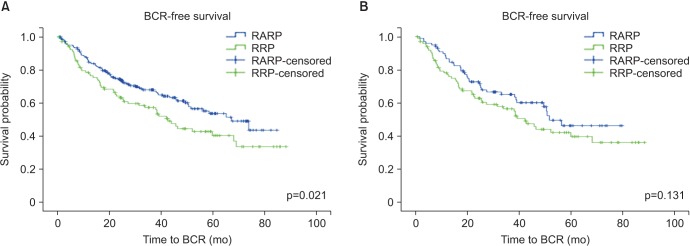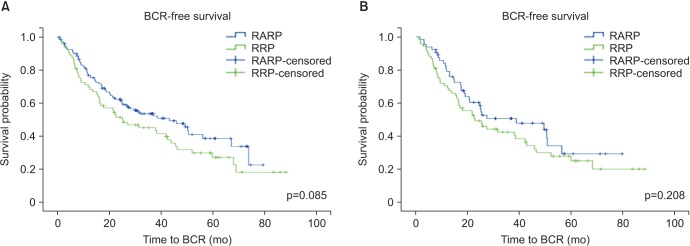Korean J Urol.
2015 Aug;56(8):572-579. 10.4111/kju.2015.56.8.572.
Comparative analysis of oncologic outcomes for open vs. robot-assisted radical prostatectomy in high-risk prostate cancer
- Affiliations
-
- 1Department of Urology, Asan Medical Center, University of Ulsan College of Medicine, Seoul, Korea. hjahn@amc.seoul.kr
- 2Department of Urology, Kyung Hee University School of Medicine, Seoul, Korea.
- 3Department of Urology, Eulji University Hospital, Eulji University School of Medicine, Daejeon, Korea.
- KMID: 2164408
- DOI: http://doi.org/10.4111/kju.2015.56.8.572
Abstract
- PURPOSE
To evaluate the oncologic outcomes of robot-assisted radical prostatectomy (RARP) in high-risk prostate cancer (PCa), we compared the surgical margin status and biochemical recurrence-free survival (BCRFS) rates between retropubic radical prostatectomy (RRP) and RARP.
MATERIALS AND METHODS
A comparative analysis was conducted of high-risk PCa patients who underwent RRP or RARP by a single surgeon from 2007 to 2013. High-risk PCa was defined as clinical stage> or =T3a, biopsy Gleason score 8-10, or prostate-specific antigen>20 ng/mL. Propensity score matching was performed to minimize selection bias, and all possible preoperative and postoperative confounders were matched. A Kaplan-Meier analysis was performed to assess the 5-year BCRFS, and Cox regression models were used to evaluate the effect of the surgical approach on biochemical recurrence.
RESULTS
A total of 356 high-risk PCa patients (106 [29.8%] RRP and 250 [70.2%] RARP) were included in the final cohort analyzed. Before adjustment, the mean percentage of positive cores on biopsy and pathologic stage were poorer for RRP versus RARP (p=0.036 vs. p=0.054, respectively). The unadjusted 5-year BCRFS rates were better for RARP than for RRP (RRP vs. RARP: 48.1% vs. 64.4%, p=0.021). After adjustment for preoperative variables, the 5-year BCRFS rates were similar between RRP and RARP patients (48.5% vs. 59.6%, p=0.131). The surgical approach did not predict biochemical recurrence in multivariate analysis.
CONCLUSIONS
Five-year BCRFS rates of RARP are comparable to RRP in high-risk PCa. RARP is a feasible treatment option for high-risk PCa.
MeSH Terms
Figure
Reference
-
1. Lowrance WT, Eastham JA, Savage C, Maschino AC, Laudone VP, Dechet CB, et al. Contemporary open and robotic radical prostatectomy practice patterns among urologists in the United States. J Urol. 2012; 187:2087–2092. PMID: 22498227.
Article2. Shikanov SA, Zorn KC, Zagaja GP, Shalhav AL. Trifecta outcomes after robotic-assisted laparoscopic prostatectomy. Urology. 2009; 74:619–623. PMID: 19592075.
Article3. Hu JC, Gu X, Lipsitz SR, Barry MJ, D'Amico AV, Weinberg AC, et al. Comparative effectiveness of minimally invasive vs open radical prostatectomy. JAMA. 2009; 302:1557–1564. PMID: 19826025.
Article4. Kim SC, Song C, Kim W, Kang T, Park J, Jeong IG, et al. Factors determining functional outcomes after radical prostatectomy: robot-assisted versus retropubic. Eur Urol. 2011; 60:413–419. PMID: 21612859.
Article5. Sooriakumaran P, Haendler L, Nyberg T, Gronberg H, Nilsson A, Carlsson S, et al. Biochemical recurrence after robot-assisted radical prostatectomy in a European single-centre cohort with a minimum follow-up time of 5 years. Eur Urol. 2012; 62:768–774. PMID: 22633365.
Article6. Liss MA, Lusch A, Morales B, Beheshti N, Skarecky D, Narula N, et al. Robot-assisted radical prostatectomy: 5-year oncological and biochemical outcomes. J Urol. 2012; 188:2205–2210. PMID: 23083657.
Article7. Suardi N, Ficarra V, Willemsen P, De Wil P, Gallina A, De Naeyer G, et al. Long-term biochemical recurrence rates after robot-assisted radical prostatectomy: analysis of a single-center series of patients with a minimum follow-up of 5 years. Urology. 2012; 79:133–138. PMID: 22088567.
Article8. Menon M, Bhandari M, Gupta N, Lane Z, Peabody JO, Rogers CG, et al. Biochemical recurrence following robot-assisted radical prostatectomy: analysis of 1384 patients with a median 5-year follow-up. Eur Urol. 2010; 58:838–846. PMID: 20869162.
Article9. Busch J, Magheli A, Leva N, Hinz S, Ferrari M, Friedersdorff F, et al. Matched comparison of outcomes following open and minimally invasive radical prostatectomy for high-risk patients. World J Urol. 2014; 32:1411–1416. PMID: 24609219.
Article10. Wambi CO, Siddiqui SA, Krane LS, Agarwal PK, Stricker HJ, Peabody JO. Early oncological outcomes of robot-assisted radical prostatectomy for high-grade prostate cancer. BJU Int. 2010; 106:1739–1745. PMID: 20575980.
Article11. Punnen S, Meng MV, Cooperberg MR, Greene KL, Cowan JE, Carroll PR. How does robot-assisted radical prostatectomy (RARP) compare with open surgery in men with high-risk prostate cancer? BJU Int. 2013; 112:E314–E320. PMID: 23451984.
Article12. National Comprehensive Cancer Network clinical practice guidelines in oncology (NCCN Guidelines): Colon/rectal cancer. ver. 1. 2010 [Internet]. Fort Wathington: National Comprehensive Cancer Network;c2015. cited 2015 Apr 21. Available from: http://www.nccn.org/professionals/physician_gls/f_guidelines.asp.13. Prostate cancer: diagnosis and treatment. NICE guidelines (CG58). Published date: February 2008 [Internet]. London: National Institute for Health and Care Excellence;c2014. cited 2015 Apr 21. Available from: https://www.nice.org.uk/guidance/cg58.14. Song C, Seo S, Ahn H, Byun SS, Cho JS, Choi YD, et al. Percent tumor volume predicts biochemical recurrence after radical prostatectomy: multi-institutional data analysis. Int J Clin Oncol. 2012; 17:355–360. PMID: 21818571.
Article15. Rosen MA, Goldstone L, Lapin S, Wheeler T, Scardino PT. Frequency and location of extracapsular extension and positive surgical margins in radical prostatectomy specimens. J Urol. 1992; 148(2 Pt 1):331–337. PMID: 1635129.16. D'Agostino RB Jr. Propensity score methods for bias reduction in the comparison of a treatment to a non-randomized control group. Stat Med. 1998; 17:2265–2281. PMID: 9802183.17. Pierorazio PM, Mullins JK, Eifler JB, Voth K, Hyams ES, Han M, et al. Contemporaneous comparison of open vs minimally-invasive radical prostatectomy for high-risk prostate cancer. BJU Int. 2013; 112:751–757. PMID: 23356390.
Article18. Hu JC, Gandaglia G, Karakiewicz PI, Nguyen PL, Trinh QD, Shih YC, et al. Comparative effectiveness of robot-assisted versus open radical prostatectomy cancer control. Eur Urol. 2014; 66:666–672. PMID: 24602934.
Article19. Karnes RJ, Joniau S, Blute ML, Van Poppel H. Caveat emptor. Eur Urol. 2014; 66:673–675. PMID: 24674148.
Article20. Park J, Yoo DS, Song C, Park S, Park S, Kim SC, et al. Comparison of oncological outcomes between retropubic radical prostatectomy and robot-assisted radical prostatectomy: an analysis stratified by surgical experience. World J Urol. 2014; 32:193–199. PMID: 24062092.
Article21. Gandaglia G, Abdollah F, Hu J, Kim S, Briganti A, Sammon JD, et al. Is robot-assisted radical prostatectomy safe in men with high-risk prostate cancer? Assessment of perioperative outcomes, positive surgical margins, and use of additional cancer treatments. J Endourol. 2014; 28:784–791. PMID: 24499306.
Article22. Wilt TJ, Brawer MK, Jones KM, Barry MJ, Aronson WJ, Fox S, et al. Radical prostatectomy versus observation for localized prostate cancer. N Engl J Med. 2012; 367:203–213. PMID: 22808955.
Article23. Bill-Axelson A, Holmberg L, Garmo H, Rider JR, Taari K, Busch C, et al. Radical prostatectomy or watchful waiting in early prostate cancer. N Engl J Med. 2014; 370:932–942. PMID: 24597866.
Article24. Abdollah F, Sun M, Schmitges J, Thuret R, Bianchi M, Shariat SF, et al. Survival benefit of radical prostatectomy in patients with localized prostate cancer: estimations of the number needed to treat according to tumor and patient characteristics. J Urol. 2012; 188:73–83. PMID: 22578732.
Article25. Ploussard G, Masson-Lecomte A, Beauval JB, Ouzzane A, Bonniol R, Buge F, et al. Radical prostatectomy for high-risk prostate cancer defined by preoperative criteria: oncologic follow-up in national multicenter study in 813 patients and assessment of easy-to-use prognostic substratification. Urology. 2011; 78:607–613. PMID: 21783233.
Article
- Full Text Links
- Actions
-
Cited
- CITED
-
- Close
- Share
- Similar articles
-
- Initial experience with Retzius-sparing robot-assisted radical prostatectomy compared to the conventional method: is it a suitable option for robotic prostatectomy beginners?
- Robot-Assisted Laparoscopic Radical Prostatectomy
- A Case of Robot-Assisted Laparoscopic Radical Prostatectomy in Primary Small Cell Prostate Cancer
- Radical Prostatectomy
- Clinical Experience with Limited Lymph Node Dissection for Prostate Cancer in Korea: Single Center Comparison of 247 Open and 354 Robot-Assisted Laparoscopic Radical Prostatectomy Series



